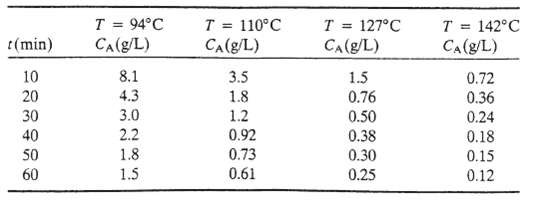You are performing an experiment in which the concentration, CA, of a reactive species is measured as
Question:
You are performing an experiment in which the concentration, CA, of a reactive species is measured as a function of time, t, at several temperatures, T. At a fixed temperature, CA varies with t according to the relation 1/CA = 1/CA0 + kt where CA (mol/liter) is the concentration of A at time t (min, CA0 (mol/liter) is the initial concentration of A, and k [L/(mol ? min)] is the reaction rate constant. The rate constant in turn depends on temperature, according to the formula k = k0 exp [? E / (8.314T)] where k0 is constant, T (K) is the reactor temperature, and E (J/mol) is the reaction activation energy. Write a computer program that will carry out the following tasks:
(a) Read in MA, the molecular weight of A, and NT, the number of temperatures at which measurements was made.?
(b) For the first temperature, read in the value of T in ?C, the number of data points, N; and the concentrations and times (t1, CA1), (t2, CA2), . . . ,(tn, CAn), where the times are in minutes and the concentrations are in grams of A/liter.
(c) Convert the temperature to Kelvin and the concentrations to mol A/L.
(d) Use the method of least squares (Appendix A.1) in conjunction with Equation 1 to find the value of k that best fits the data. Store the values of k and T in arrays.
(e) Print out in a neat formats the values of T (K), the converted concentrations (mol/L) and times, and k.
(f) Repeat steps (b) through (d) for the other temperatures. It will be convenient to perform the least-squares slope calculation in a subroutine, since it must be done repeatedly. Test your program on the following data: MA = 65.0 g/mol

Step by Step Answer:

Elementary Principles of Chemical Processes
ISBN: 978-0471720638
3rd Edition
Authors: Richard M. Felder, Ronald W. Rousseau





